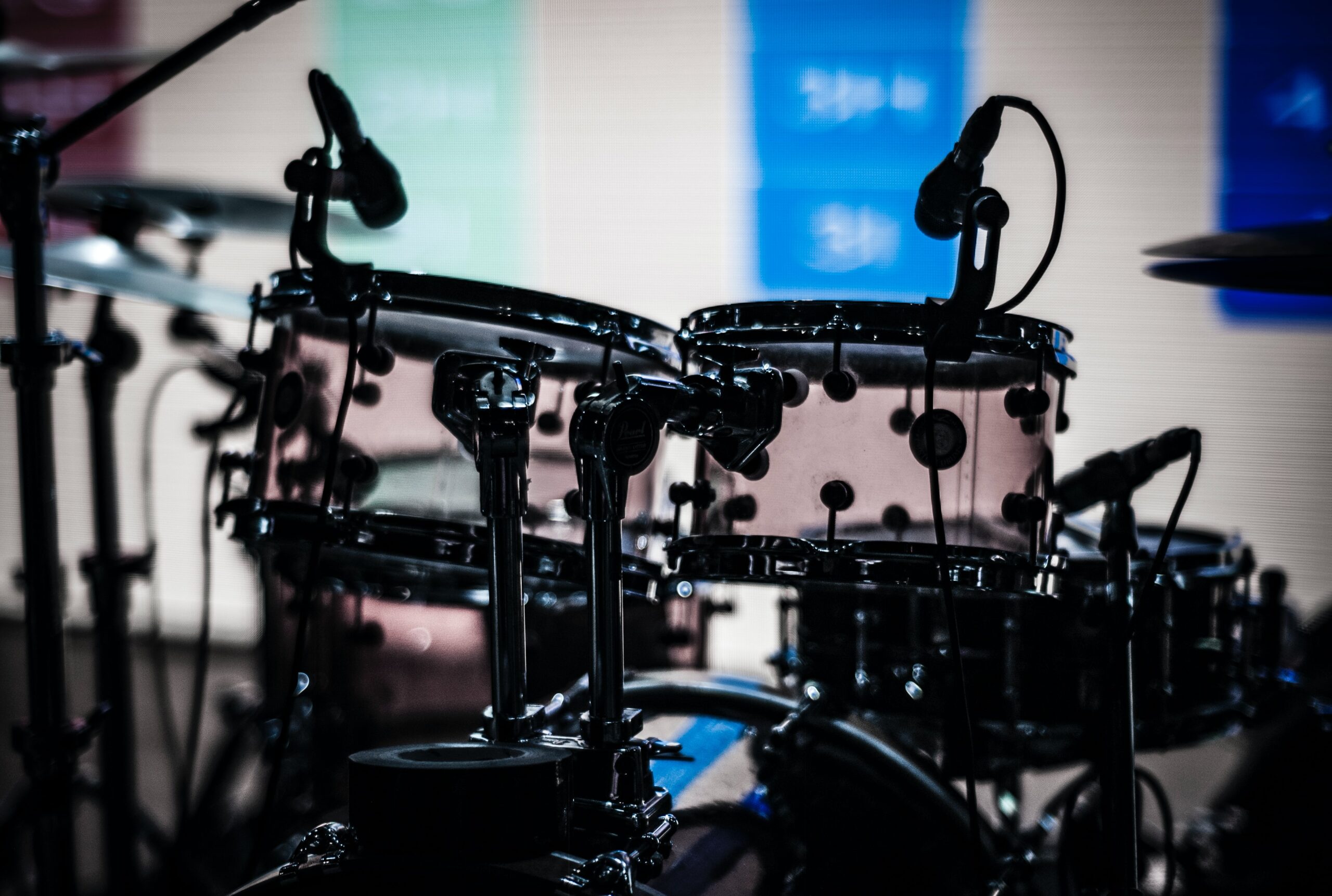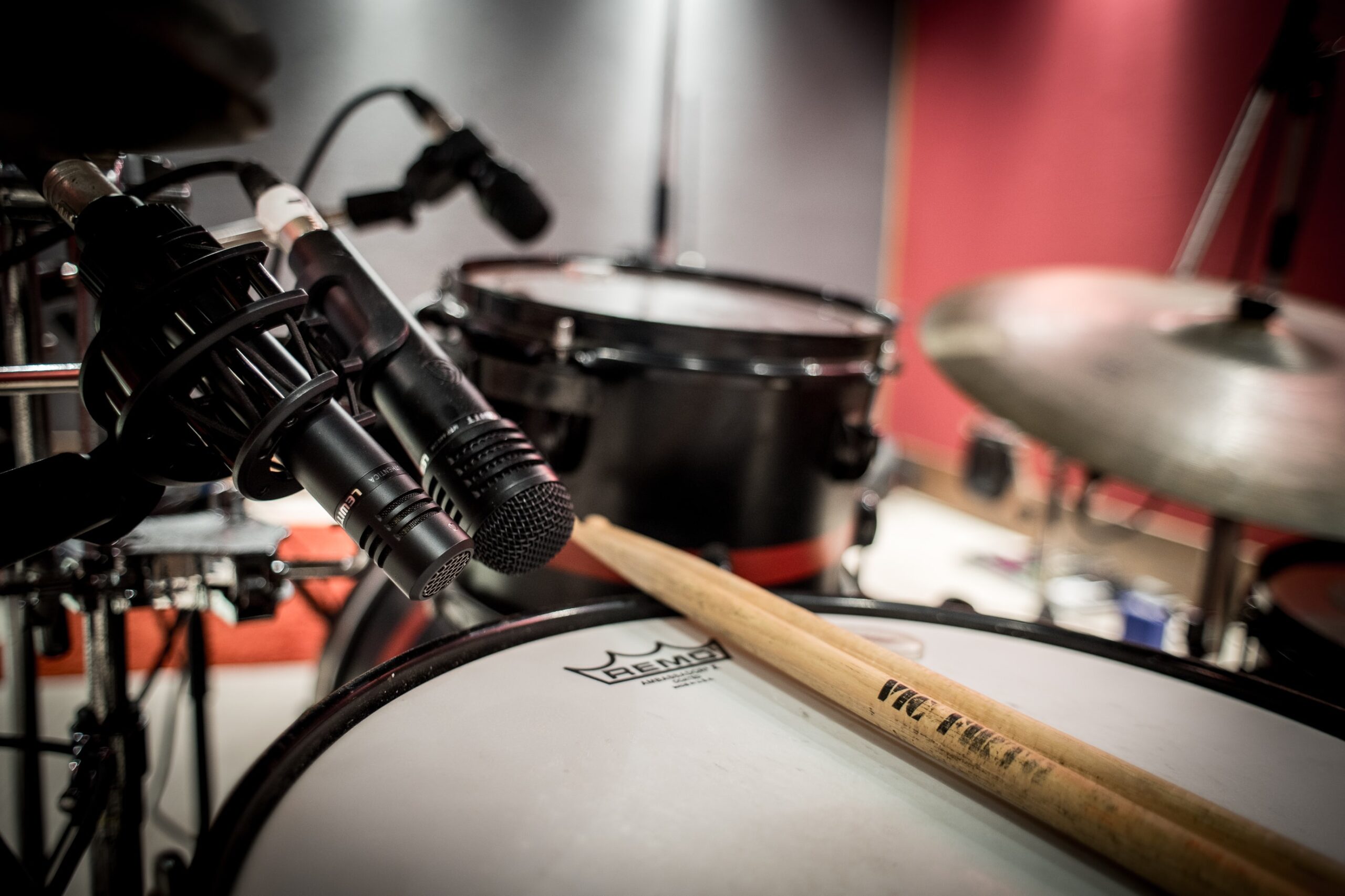Whether you’re playing in a studio or on the stage, mics are something you’re going to need to be familiar with as a drummer. They help both in recording clear sounds from the kit and in amplifying your drums. So, to get the best payout from your kit, you need to make sure you’re getting the right types of mics. This article will discuss the mics you need to record your drums and answer questions like:
- What are drum mics?
- What do you look for in a good drum mic?
- How to set up your drum mics?
Drum Mic Categories
- Bass/Kick drum mic
- Snare drum mic
- Tom drum mic
- Hi-hat cymbal mic
What Are Drum Mics?

Drum mics are microphones placed around the kit to record the sound of each of its instruments. You can choose one of three mics for each drum: ribbon, condenser, or dynamic.
A type of mic is chosen for each depending on the function it serves. These are then set either over, under, or in both places around the drums. The mics around each drum ensure that all the drums are captured equally loud and strong.
Only the hi-hat cymbals have a special mic, and all other cymbals are recorded using mics held over the kit using stands. This helps control the volume of the cymbals.
What Are The Different Types of Drum Mics?
Kick/ Bass Drum Mics
A bass drum is the foundation of any drum kit, so it makes sense to have a good mic to record it. The drum produces sound with low frequency and high-pressure levels (SPL). So, a dynamic mic is perfect for a bass drum as it works well with loud sounds.
You can also use a condenser mic if you keep it a foot away from the drum. Any mic should face the area where the bass pedal strikes the drumhead but on the opposite side of the drum.
Read Also: 5 Best Bass Drum Pedals in 2021
Snare Drum Mics
Snare drums are generally recorded using one or two mics. The mic is held over the snare, and when two are used, one is placed over the drum to record it being played, while the other is placed under to record the snares.
You want to use a condenser mic for your snare because it’s very sensitive to sound. A snare drum is an important part of any kit, so you want it to be recorded clearly.
Tom Drum Mics
You can use either condenser and dynamic mics for your toms. Using a condenser mic will record your toms distinctly, while a dynamic mic will provide an extra thump.
Hi-hat Cymbal Mic
A condenser mic is used for the hi-hat cymbals, and one with a small diaphragm provides the best result. You want to use a cardioid mic with an extremely fast response for your hi-hat. The cymbal has very fast transients, so the mic should have a strong transient response too.
How Do Drum Mics Work?
A mix of the three mics is used to get the best sounds from any drum kit. Each drum and the hi-hat cymbal have one or two mics set around them. One or two mics are also held overhead to record the kit as a whole. All these types of mics function differently and suit different purposes.
Dynamic Mics
Dynamic mics operate using a metal coil set in a magnetic field. Loud sound waves cause the coil to vibrate against the magnetic field, which induces a current that is recorded by the system. These mics work best for loud sounds like live performances and large drums.
Condenser Mics
Condenser mics are made with a thin diaphragm that vibrates when sound waves hit it. The diaphragm is made of a thin material which makes the mic sensitive to delicate sounds.
Ribbon Mics
A ribbon mic works with a thin aluminum film that stands between two poles of a magnet. The vibration of this film creates a voltage that is recorded.
What Do You Look For In Drum Mics?
Direction
Mics can be unidirectional, bidirectional, and omnidirectional, and all of them serve different purposes. Omnidirectional mics capture sound from all sides and are perfect for bass drums because they capture thump better.
Unidirectional mics are best for snares because they zone out noise and isolate the sound you want, clarifying the final result.
Accessories
You always want to check what accessories your mics come with. Good mics, whether dynamic or condenser, will come with windscreens and mic clips that’ll help mount them. Mics don’t come with stands—or XLR cables if they need those— so you’ll need to purchase those.
Read Also: 5 Best XLR Cables For Microphones
Size
No matter where and what you’re recording, you can never go wrong with a compact mic. They are easy to arrange, are visually unobtrusive, and can work with almost all stands. Compact mics are also easy to carry and can be set anywhere, even on the inside of the drums.
Price and Warranty
A drum kit will require a group of mics to be recorded, and splurging on very expensive mics isn’t always ideal. Mics do have a difference in the final results, but investing in good-quality drums and tuning them right makes a bigger difference.
Go for mics that have good reviews, and invest in pairs if possible. If you’re on the road drumming, invest in microphones that have at least 1-2 years of warranty, even if they cost you a little more.
How Do You Set Drum Mics Up?
Mics are set in different ways around different drums to get the clearest sound possible. Here’s how you can go about setting up your mics.
Kick/Bass Drums
Bass drums usually have two mics set around them: one on the outside, and one on the inside. The mic on the inside is slipped through a hole in the drum and sits behind the drumhead, right where the beater hits it.
Some drummers like to move the mic slightly towards the rim to get some of the wooden thumps. The mic on the inside of the drum is usually a dynamic mic, and can be both set on the drum, or dangled behind the head.
On the other hand, the mic on the outside of the drum is a condenser mic. You don’t just want the mic to record the beat of the bass drum; you also need some of the natural air sounds of the drum. Condenser mics work well for capturing those natural sounds.
Here’s a quick video tutorial to help you understand better:
https://www.youtube.com/watch?v=fU1a_fZvzs0
Snare Drums
You can set up a mic near the top head of the snare, or use two—one for the top head, and one for the bottom. To use one single mic for the snare, choose a unidirectional mic, whether dynamic or condenser.
Keep that mic a little higher than the snare and tilt it downwards towards the head. If you want a heavy, battering sound, face the mic near the center of the drumhead. However, if you want a more snare-like quality to the sound, move the mic towards the rim.
To use two mics, simply set one over the top, facing the center of the top head. Set the other under the drum so that it captures the snare—the metal wires that rattle inside the drum— once it is played.
This example should help you better understand what we mean: https://www.youtube.com/watch?v=mN9lvpp088U
Tom Mics
If your kit has one tom, you can use a unidirectional mic, while an omnidirectional mic works well for kits with two toms. Place the omnidirectional mic between the two toms so that it captures both of them.
You can also use two mics— one for each drum—but we advise against it. Given how close the toms are, the sound will overlap and there will be phase issues in post-production.
Follow this video guide to better understand how to mic your toms: https://www.youtube.com/watch?v=Vou6KzJzGk8
Hi-hat Cymbal
While all other cymbals are recorded through overhead miking, hi-hat cymbals have their own mic. The easiest way to record a hi-hat is to place the mic stand right beside the hi-hat stand.
Read Also: 5 Best Hi Hat Stand For Double Bass
You can do this in two ways—either keep the mic over the hi-hat and face it downwards or place it under the hi-hat facing upwards. We recommend keeping the mic 5-15 cm over the top of the hi-hat. This will make sure your mic catches the hi-hat only and will help zone out the sound of the other drums.
Placing your mic under the cymbal will prevent it from catching the warm sound produced when the stick hits the cymbal. Instead, all you’ll catch is the clanging of the two hi-hat cymbals.
If you’re looking for more detail on setting up the mics for your hi-hat cymbals, here’s a video that’ll help you out.
https://www.youtube.com/watch?v=F1VUgk0bdI8
Final Thoughts On Drum Mics
The trick to recording the clearest sound from your drum kit is to buy good quality drums, make sure they are tuned, invest in good quality drum mics, and then place the mics right. All of these steps when done together, will bring out your drum kit’s full potential. Investing in the right drum mic can be scary, but the only way to know what suits your taste best is to try it out.


